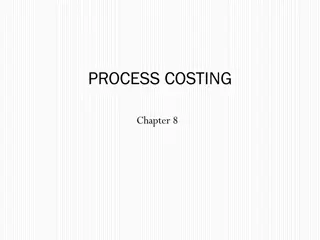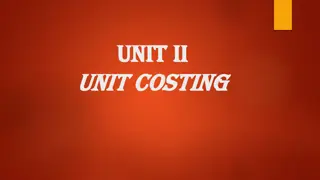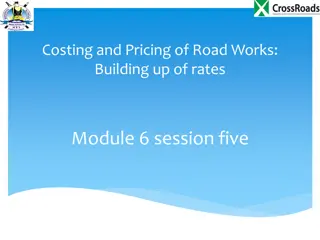Introduction to Industrial Costing: Understanding Cost Types and Accounting Systems
Explore the fundamentals of industrial costing, including different cost types and accounting systems such as actual cost accounting, normal cost accounting, and standard cost accounting. Learn about cost data control, tasks of cost accounting, and the integration of cost type accounting in cost and performance accounting. Gain insights into flow variables, time-based cost accounting systems, and the importance of cost control in decision-making processes.
Download Presentation

Please find below an Image/Link to download the presentation.
The content on the website is provided AS IS for your information and personal use only. It may not be sold, licensed, or shared on other websites without obtaining consent from the author. Download presentation by click this link. If you encounter any issues during the download, it is possible that the publisher has removed the file from their server.
E N D
Presentation Transcript
Lecture Industrial Costing SS 2016/2017 Prof. Dr. Olga Popova, OVGU Prof. Dr. J rg Jablinski, OWL 1
Chapter 2 Cost type accounting (Part 1) 2
Flow Variables Flow Variables Inpayment Content Inflows of cash or cash equivalents (Cash and demand deposits for example Transfers and cheques) outs of cash or cash equivalents (cash and demand deposits) An increase of financial assets. A receipt is defined as the value of all sold goods and services over one (given) period of time A decrease of financial assets. An expenditure is defined as the value of all goods and services received over one (given) period of time Value of all goods and services produced over one (given) period of time Value of all goods and services consumed over one (given) period of time Value of all goods and services produced over one (given) period of time according to the type of operating activity Value of all goods and services consumed over one (given) period of time to produce a product Outpayment Revenues Expenditures Proceeds Expenses Performances Costs 3
Time-based cost accounting systems Actual Cost Accounting Analysis of the past operation activities (post calculation) Actual costs of a past period past Normal Cost Accounting Analysis of the past operation activities Average cost over several periods which is adjusted for outliers Data base for the future decisions Standard Cost Accounting Basis for decisions future Planning with expected future costs Planned targets for target- actual comparison 4
Tasks of Cost Accounting Cost Data Cost Control Cumulating all costs Budgeting Processing Material Costs Determination of the consumption - access method - stocks method - update method - retrograde method Evaluation of the consumption - Fixed price method - Collective valuation method Staff Costs External Service Costs with Taxes and Fees Imputed Costs Imputed amortization Imputed interest imputed employer's salary Imputed risks Imputed rent Income Controlling Tasks Decisions 5
Integration of cost type accounting in the cost and performance accounting Cost Type Accounting Question: What costs have been incurred? overheads Cost Center Accounting direct costs Question: Where costs have been incurred ? allocation/distribution Cost Unit Accounting Question: For what costs have been incurred? 6
Principles of cost type accounting Principles Unambiguity Direct costs must be assigned to specific expenses without a doubt. Too extensive plan as well as the breakdown by several properties complicates the review of individual elements of cost. It must be avoided Completeness All costs incurred by the company should be considered. Through a complete listing of all costs mistakes can be avoided. The cost element plan should be flexible so it can be adjusted to reflect the new realities The cost type accounting should be based on economic grounds. Expenses for accounting should be minimal. Flexibility Economic efficiency 7
The main cost types Cost types Material Costs Staff Costs External Service Costs, Public Fees and Taxes Imputed Costs 8
Methods for calculating the material consumption Methods for calculating the material consumption Stock Outflow Stock Inflow Access method Stock method Update method Retrograde method 9
How does Access Method work Material Consumption = Sum of all Inflows According to the Delivery 10
How does stock method work initial stocks according to stocks at the beginning of a period + Inflows according to the delivery during the period - final stocks at the end of a period Consumption during the period Example: Calculating the material consumption initial stocks = final stocks according to inventory 2015 + Inflow on January 2016 + Inflow on February 2016 + + Inflow on December 2016 - final stocks according to stocks 2016 Consumption 2016 11
How does update method work Material Consumption = Sum of all Outflows According to the material requisition card Calculating of the extraordinary consumption Actual initial inventory (according to inventory) + Actual Inflows (according to delivery notes) - Actual Outflows (consumption detected by material requisition card) = Standard final inventory (according to inventory accounting) - Actual final inventory (according to inventory) = extraordinary consumption 12
How does retrograde method work Consumption Volume = (expected consumption per product unit) * (produced quantity) On the following slides you will find examples of calculating the material consumption 13
Process Initial stocks Inflow Outflow Inflow Outflow Outflow Inflow Outflow Final stocks Datum Amount 4.000 units 2.000 units 2.400 units 2.000 units 3.000 units 2.500 units 4.000 units 2.200 units 1.400 units Stocks of July: 01.07. 07.07. 08.07. 13.07. 16.07. 21.07. 25.07. 27.07. 31.07. In July the following products were produced: Needed quantity for each product Product Amount A 600 products 6 units per product B 800 products 4 units per product C 400 products 8 units per product Determine the quantitative consumption according to the different methods: 14
a) access method Consumption = All Inflows= 8.000 Units b) stock method Consumption = Initial Stocks + Inflows - Final Stocks initial stocks 4.000 Units + Inflow on 07.07. 2.000 Units + Inflow on 13.07. 2.000 Units + Inflow on 25.07. 4.000 Units - final stocks on 31.07. 1.400 Units Consumption 10.600 Units c) update method Consumption = Sum of all Outflows According to the material requisition card Outflow on 08.07. + Outflow on 16.07. + Outflow on 21.07. + Outflow on 27.07. 2.400 Units 3.000 Units 2.500 Units 2.200 Units Consumption 10.100 Units 15
d) retrograde method Consumption = Sum of all Outflows According to the material requisition card Consumption = expected consumption per unit of product A * produced quantity + expected consumption per unit of product B * produced quantity + expected consumption per unit of product C * produced quantity = 6 Units * 600 + 4 Units * 800 + 8 Units * 400 Consumption = 10.000 St. 16
Methods of Calculating the Consumption of Stocks the periodic average method Average price method the weighted average method evaluation methods with cost price as a base FIFO method LIFO method sequence of consumption method HIFO method LOFO method 17
Value of the Initial Stock + Value of all Deliveries of the Period Periodic Average Price = Amount of Initial Stock + Amount of all Deliveries of the Period 18
Example: Methods of calculating the stocks consumption Process Initial Stock Inflow Outflow Inflow Outflow Outflow Inflow Outflow Final Stock Datum 01.10. 07.10. 09.10. 13.10. 17.10. 21.10. 23.10. 28.10. 31.10. Amount 300 u. 200 u. 250 u. 300 u. 500 u. 50 u. 400 u. 150 u. 250 u. Unit price 10,- /u. 15,- /u. Total value 3.000,- 3.000,- 15,- /u. 4.500,- 12,- /u. 4.800,- 19
a) According to the periodic average method Process Initial Stock + Inflow + Inflow + Inflow = Sum Outflow = Final Stock Datum 01.10. 07.10. 13.10. 23.10. Amount 300 u. 200 u. 300 u. 400 u. = 1.200 u. 950 u. =250 u. Unit price 10, /u. 15, /u. 15, /u. 12, /u. 12,75, /u. 12,75, /u. 12,75, /u. Total value 3.000,- 3.000,- 4.500,- 4.800,- = 15.300,00 12.112,50 = 3.187,50 31.10. 20
b) According to the weighted average cost method Process Initial Stock + Inflow = Intermediate Stocks Datum 01.10. 07.10. Amount 300 u. +200 u. = 500 u. Unit price 10,- /u. 15,- /u. 12,00 /u. Total value 3.000,- +3.000,- = 6.000,- Outflow + Inflow 09.10. 13.10. 250 u. +300 u. = 550 u. 12,00 /u. 15,- /u. 13,64 /u. 3.000,- +4.500,- = 7.500,- = Intermediate Stocks Outflow Outflow + Inflow 17.10. 21.10. 23.10. 500 u. 50 u. +400 u. = 400 u. 13,64 /u. 13,64 /u. 12,- /u. 12,00 /u. 6.820,- 680,- +4.800,- = 4.800,- = Intermediate Stocks Outflow = Final Stock 28.10. 31.10. 150 u. 250 u. 12,00 /u. 12,00 /u. 1.800,- = 3.000,- 12.300,- Material Consumption Evaluation of Material Consumption in October = 3.000,- + 6.820,- + 680,- + 1.800,- = 12.300,- 21
Example: method of calculating the consumption of stocks Method Datum Consumption (950 Units) final stock (250 Units) FIFO method 01.10. 07.10. 13.10. 23.10. 300 St. x 10,- /Unit + 200 St. x 15,- /Unit + 300 St. x 15,- /Unit + 150 St. x 12,- /Unit = 12.300,- 250 St. x 12,- /Unit = 3.000,- LIFO method (time-based) 23.10. 13.10. 07.10. 01.10. 400 St. x 12,- /Unit. + 300 St. x 15,- /Unit + 200 St. x 15,- /Unit + 50 St. x 10,- /Unit = 12.800,- 250 St. x 10,- /Unit = 2.500,- LIFO method (permanent) 07.10. 01.10. 13.10. 01.10. 01.10. 23.10. 200 St. x 15,- /Unit + 50 St. x 10,- /Unit + 300 St. x 15,- /Unit + 200 St. x 10,- /Unit + 50 St. x 10,- /Unit + 150 St. x 12,- /Unit = 12.300,- 250 St. x 12,- /Unit = 3.000,- HIFO method 07.10. 13.10. 23.10. 01.10. 200 St. x 15,- /Unit + 300 St. x 15,- /Unit + 400 St. x 12,- /Unit + 50 St. x 10,- /Unit = 12.800,- 250 St. x 10,- /Unit = 2.500,- LOFO method 01.10. 23.10. 07.10. 13.10. 300 St. x 10,- /Unit + 400 St. x 12,- /Unit + 200 St. x 15,- /Unit + 50 St. x 15,- /Unit = 11.550,- 250 St. x 15,- /Unit = 3.750,- 22
Valuation Assumption of the final stock of the consumption Available at the beginning of the period stocks or supplied materials are consumed the first with the prices of the initial stock and the first received materials with the prices of the latest received materials FIFO with the prices of the initial stock and the prices of the first (material) Inflows during the period with the prices of the of the last (material) Inflows during the period Last received materials are consumed the first LIFO The most expensive materials are consumed the first Goods purchased at a low price are consumed the first with the lowest prices with the highest prices HIFO with the highest prices with the lowest prices LOFO 23
Summary Material Costs Evaluation of material consumption = consumed amount x cost value Direct costs: raw materials, auxiliaries Overheads: (auxiliaries), operating materials Average cost method Periodic average price = Value of OB + value of all the delivery. (Period) Amount of OB + amount of all delivery. (Period) Determination of material consumption Sliding method: Evaluating of average after each inflow Also evaluating outflows Access Method: Material Consumption = Sum of all Inflows according to the Delivery Stocks Method: Sequence of consumption: Time based: FIFO, LIFO method Price based: HIFO-, LOFO method initial stocks according to stocks at the beginning of a period + Inflows according to the delivery during the period - final stocks at the end of a period = Consumption during the period Update Method: Actual initial inventory (according to inventory) + Actual Inflows (according to delivery notes) - Actual Outflows (consumption detected by material requisition card) = Standard final inventory (according to inventory accounting) - Actual final inventory (according to inventory) = extraordinary consumption Retrograde method : Consumption Volume = (expected consumption per product unit) * (produced quantity) 24























